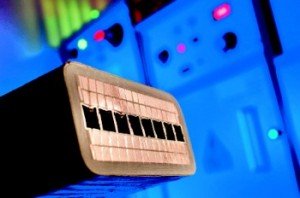Jul 16 2010
Siemens is searching for insulators that will make generators more efficient. The electrical energy in generators is generated in copper bars insulated against high electrical voltages with thick layers of plastic. New materials would enable a thinner design for these insulators, freeing up space for thicker bars in which ultimately more energy could be generated.
That would make it relatively easy to adapt a generator to a more powerful turbine. Siemens Corporate Technology (CT) is working with Siemens Energy and additional industry and research partners to develop new insulators containing nanoparticles. As reported in the current issue of Pictures of the Future, the materials have already proven effective in the laboratory. The next step is to ready the technology for the market.

The voltage between the copper bars of a generator can be in the tens of thousands of volts. This ionizes the air, leading to partial discharges. The lighting flashes attack the copper conductor’s insulation and produce erosion channels that propagate in the protective coating. If they reach the metal, these channels can trigger short circuits. This is why particles of mica, a special silicate, are added to the plastic used for the insulator. Because the erosion channels have to go around the tiny scales of mica, it takes longer for them to reach the copper, and the insulator can withstand continuously higher voltages.
The Siemens CT researchers and their partners are studying the insulating effect of nanoparticles made of silicates. Measuring just a few millionths of a millimeter, the tiny balls have an extremely large surface area and lengthen the detour for the erosion channels tremendously. Insulators to which the nanoparticles have been added in addition to the mica scales exhibit up to ten times greater resistance to partial discharges in the laboratory. For their next step, the researchers hope to use such nanoinsulators to make the insulation layers, some of which are centimeters thick, roughly 25 percent thinner.
Siemens CT coordinated the work as part of the NanoIso project, which was funded by the German Ministry of Education and Research and concluded in March. The insulators will be further refined and tested in a prototype generator over the course of a four-year follow up project scheduled to begin in August.